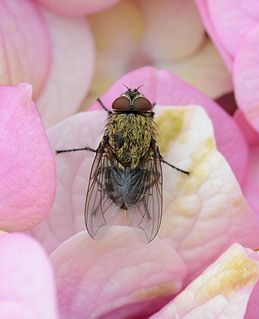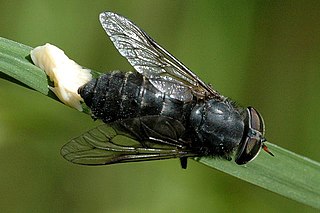
The Calliphoridae are a family of insects in the order Diptera, with 1,200 known species. The maggot larvae, often used as fishing bait, are known as gentles. The family is known to be polyphyletic, but much remains disputed regarding proper treatment of the constituent taxa, some of which are occasionally accorded family status.

Cluster flies are flies of the genus Pollenia in the family Polleniidae. Unlike the more familiar blow flies, such as the bluebottle genus Phormia, they are completely harmless to human health because they do not lay eggs in human food. They are strictly parasitic on earthworms; the females lay their eggs near earthworm burrows, and the larvae then feed on the worms. Cluster flies seek refuge in cold weather and find their way into attic spaces and similar areas indoors. They often emerge on warm days, and cluster at windows attempting to exit.

Pollenia rudis, the common cluster fly, is a species of fly in the family Polleniidae. Pollenia rudis is also known as the attic fly, the loft fly, pollenie du lombric [French], and the buckwheat fly. During the autumn and winter months, Pollenia rudis can be found overwintering inside attics or lofts. This sluggish species can be found “clustering” near the interior windows of a warm structure.
Melanodexia is a peculiar New World cluster fly genus of the western United States, formerly included in the family Calliphoridae.

Hybomitra is a genus of horse flies in the family Tabanidae. There are at least 240 described species in Hybomitra.
Bampura is a genus of bristle flies in the family Tachinidae. There are at least two described species in Bampura.
Calliphora coloradensis is a species of blow fly in the family Calliphoridae.

Pollenia vagabunda is a species of blow fly in the family Polleniidae.
Wilcoxia is a genus of robber flies in the family Asilidae. There are about five described species in Wilcoxia.

Polleniidae is a family of flies in the order Diptera. There are at least 6 genera and more than 190 described species placed definitively in Polleniidae, and other genera whose placement here is considered uncertain.The largest genus is Pollenia, with close to 190 species of flies commonly called "cluster flies".
Pollenia grunini is a species of cluster fly in the family Polleniidae.
Pollenia mystica is a species of cluster fly in the family Polleniidae.
Pollenia paragrunini is a species of cluster fly in the family Polleniidae.
Pollenia hungarica is a species of cluster fly in the family Polleniidae.
Pollenia luteovillosa is a species of cluster fly in the family Polleniidae.
Pollenia paupera is a species of cluster fly in the family Polleniidae.
Pollenia ponti is a species of cluster fly in the family Polleniidae.
Pollenia pseudintermedia is a species of cluster fly in the family Polleniidae.
Pollenia labialis is a species of cluster fly in the family Polleniidae.
Pollenia viatica is a species of cluster fly in the family Polleniidae.








